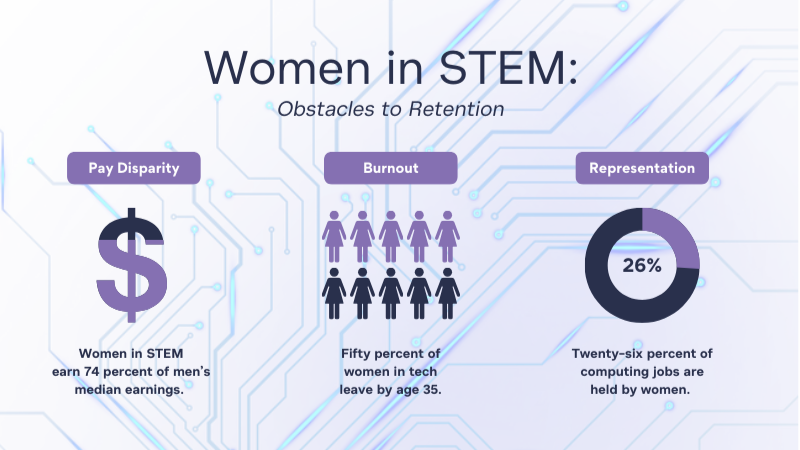Published by AlignOrg in Partnership with ITWomen
The Retention Challenge in STEM
Women in science, technology, engineering and mathematics (STEM) fields continue to face significant challenges that hinder their career advancement and long-term retention. Despite efforts to close the gender gap, persistent issues such as pay disparities, career stagnation and burnout remain critical obstacles. Organizations that fail to address these challenges and retain women in STEM careers risk losing top talent, limiting their innovation potential and reinforcing inequities in the workplace.
At AlignOrg Solutions, we focus on helping organizations design structures that drive efficiency, agility and inclusivity. In this blog, we explore how adaptive and flexible organizational strategies can help retain women in STEM. To bring real-world insights into this discussion, we have collaborated with ITWomen, a nonprofit dedicated to advancing women in STEM. ITWomen members share their experiences, offering a firsthand perspective on what’s working — and what still needs to change.
“Retention in STEM starts with a culture of continuous growth, learning and inclusion. It’s about staying curious, committing to lifelong learning — and investing in professional development, mentorship and innovative projects that empower tech talent to thrive and make meaningful impact on our community.”
-Margaret Brisbane, CIO of Miami Dade County
The Current Landscape: Why Women Leave STEM
Despite earning degrees in STEM at increasing rates, women remain underrepresented in mid-and senior-level roles across the industry. Research indicates that:
- Women in STEM occupations earn about 74% of men’s median earnings in STEM.
- 50% of women in tech leave the industry by age 35, citing workplace culture, lack of advancement or burnout.
- Only 26% of computing-related jobs are held by women, and even fewer women advance to leadership positions.

The reasons for this attrition are not accidental. They stem from structural and cultural barriers within organizations. To create meaningful change, companies must be intentional about designing work environments that support, develop and retain women in STEM careers.
“There are always challenges in career growth, and I have faced numerous instances where I felt overlooked for promotions, likely due to my unique path into IT as a woman. My advice is that how you respond to setbacks shapes a lasting impression and helps maintain your sanity. I have discovered that reacting professionally and consistently presenting your best self eventually pays off. While we may not be able to control the workplace, we can certainly control our reactions to it.”
Kirsty Dyson, SVP Online and Omnichannel for the Americas at L’Oréal
Designing Flexible Work Structures
One of the most effective ways to retain women in STEM is by rethinking how work is structured. The traditional 9-to-5, office-first model often does not accommodate the realities of employees who must balance caregiving responsibilities or seek greater autonomy in their careers.
Organizations can improve retention by:
- Embracing hybrid and remote work models to accommodate diverse needs.
- Implementing paid parental leave policies that extend beyond legal minimums.
- Creating return-to-work programs for women re-entering the workforce after career breaks.
Companies that prioritize workplace flexibility have been shown to increase retention rates, particularly among women who might otherwise leave STEM due to rigid work environments.
“Workplace flexibility is not just a perk — it can be a strategic enabler of high-performance organizations. It opens up the pool of candidates to choose the best talent. It also improves talent retention by empowering individuals to work in ways that align with both business goals and individual well-being. Implementing adaptable work models fosters a more competitive and sustainable workforce.”
Sharon Moura, Principal, AlignOrg Solutions
Building Inclusive Career Pathways
The lack of clear career progression is a major factor in why women leave STEM fields. Without structured advancement opportunities, many face stagnation or feel overlooked for leadership roles. Organizations should:
- Increase pay transparency to address gender wage gaps.
- Invest in sponsorship programs where senior leaders actively advocate for high-potential women.
- Develop structured leadership tracks that provide clear pathways for advancement.
Companies that implement these initiatives not only retain talent but also build a more diverse leadership pipeline — an essential driver of innovation and long-term success.
“In my experience, mentorship and workplace flexibility are critical components to promoting and retaining more women in technology. Companies that are intentional about providing these resources will not only foster a more inclusive workforce but also benefit enormously from the innovation and leadership that diverse teams bring.”
Claire Marrero, President, ITWomen
Combating Burnout and Fostering Well-Being
Women in STEM often experience higher levels of burnout due to workplace biases, lack of support and the pressure to constantly prove their capabilities. To create a sustainable work environment, organizations must:
- Promote work-life balance by encouraging reasonable workloads and time-off policies.
- Develop employee resource groups that provide community and advocacy.
- Prioritize mental well-being through coaching, peer support, and leadership training.
Addressing burnout is about more than offering wellness programs. It requires a cultural shift that values sustainability over productivity at all costs.
“Managing burnout begins with knowing when to set boundaries, prioritizing self-care and creating a supportive work environment. I’m a strong believer in the power of balance. Protecting our well-being isn’t just good for us personally, it’s key to our long-term success.”
Margaret Brisbane, CIO of Miami Dade County
The Business Case for Retention: Why It Matters
Beyond social responsibility, retaining women in STEM is a business imperative. Studies consistently show that diverse teams drive higher innovation, better problem-solving, and improved financial performance. Organizations that invest in retention strategies gain a competitive edge by fostering a workplace that attracts and retains top talent.
By implementing the right strategies, companies can ensure that women in STEM not only enter the field—but thrive in it.
“Over my 30-year career in tech search — and my work with ITWomen — I’ve seen that the women who rise to VP and C-suite levels don’t just work hard; they play a critical role in paving the way for others. They take on the toughest assignments, the long hours, and the extensive travel, yet they still make time to mentor, advocate, and push for greater representation in leadership pipelines. They use their platform to drive real change, securing corporate investment in programs that help the next generation of women in STEM thrive. However, with only 25% of Fortune 500 CIO roles held by women, we still have much work to do to curb the exodus of talented women who hit a wall trying to balance the demands of career, children, and aging parents — responsibilities that still disproportionately fall to women.
The reality is that until workplaces evolve to support these challenges, we will continue to see women forced to choose between the 24/7 demands of tech careers and life outside of work.”
Claire Marrero, President, ITWomen
Strategic Action Needed to Retain Women in STEM
Retaining women in STEM requires more than good intentions—it requires strategic action. Leaders must take a look at their policies, culture, and structures to remove barriers and create equitable workplaces.
Want to learn more about how your organization can future-proof its workforce? Let’s start the conversation.
Engage with AlignOrg for organizational transformation strategies.
Connect with ITWomen to support and uplift women in STEM.





